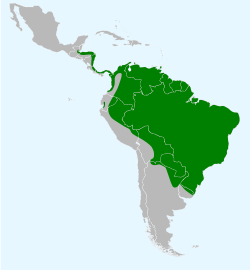Rufescent tiger heron
| Rufescent tiger heron | |
|---|---|
| | |
| in the Pantanal, Brazil | |
| Scientific classification | |
| Kingdom: | Animalia |
| Phylum: | Chordata |
| Class: | Aves |
| Order: | Pelecaniformes |
| Family: | Ardeidae |
| Genus: | Tigrisoma |
| Species: | T. lineatum |
| Binomial name | |
| Tigrisoma lineatum (Boddaert, 1783) | |
 | |
The rufescent tiger heron (Tigrisoma lineatum) is a species of heron in the family Ardeidae. It is found in wetlands from Central America through much of South America.
Taxonomy
When he first described the rufescent tiger heron in 1783, based on a specimen collected in Cayenne, French Guiana, Pieter Boddaert named it Ardea lineata.[2] In 1827, William John Swainson moved the species to his newly created genus Tigrisoma; it is now one of three species in that genus.[3] The rufescent tiger heron has two subspecies:
- T. l. lineatum, given species status by some taxonomists as lineated tiger heron, is found from Central America down into northern and central South America.[4]
- T. l. marmoratum, given species status by some taxonomists as banded tiger heron, is found in eastern and south-central South America.[4]
The genus name Tigrisoma is a combination of two Greek words: tigris, meaning "tiger" and somā, meaning "body".[5]
Description
The rufescent tiger heron is a medium-sized heron, measuring 26–30 in (66–76 cm) in length,[nb 1][7] with a mass between 630 and 980 g (22 and 35 oz).[8] The sexes are similarly plumaged.[9] The adult's head, neck and chest are dark rufous, with a white stripe down the center of the foreneck. The remainder of its upperparts are brownish with fine black vermiculations, its belly and vent are buffy-brown, and its flanks are barred black and white.[10] Its tail is black, narrowly barred with white.[11] Its stout bill is yellowish to dusky, and its legs are dull green.[10] Its irides, loral skin and orbital ring are bright yellow.[11] Unlike other tiger herons, it has no powder down feathers on its back.[9]
The juvenile bird is rusty-buff overall, coarsely barred with black; the buff and black banding on its wings is especially pronounced. Its throat, central chest and belly are white. It takes some five years to acquire adult plumage.[10]
Similar species
The adult rufescent tiger heron is relatively easy to distinguish from fasciated and bare-throated tiger herons, as it is rufous (rather than primarily gray) on the head and neck. Young birds, however, are much more difficult to identify.[7]
Distribution and habitat
The rufescent tiger heron is found in wetlands from Central America through much of South America.[10] It generally occurs below 500 m (1,600 ft), though it has been recorded as high as 1,600 m (5,200 ft) in Colombia.[7]
Behavior
It is largely crepuscular and generally solitary.[7][11]
Food and feeding
As might be expected of a species that spends most of its time by the water, much of the rufescent tiger heron's diet is aquatic-based, including fish, crustaceans, water beetles and dragonfly larvae. It also takes adult dragonflies and grasshoppers.[9] It typically hunts alone, standing hunched in shallow pools or wet areas of forest while it waits for prey.[7]
Voice
The rufescent tiger heron's main call is a low-pitched paired hoot, often given at night.[10] It also gives a fast series of sharp wok notes, which decrease in volume and speed, and a prolonged hoot, transcribed as ooooooo-ooh which rises markedly at the end.[7]

Conservation
Although the rufescent tiger heron's population size and trend has not been quantified, its range is huge, so the International Union for the Conservation of Nature lists it as a species of least concern.[1]
Notes
- ↑ By convention, length is measured from the tip of the bill to the tip of the tail on a dead bird (or skin) laid on its back.[6]
References
- 1 2 BirdLife International (2012). "Tigrisoma lineatum". IUCN Red List of Threatened Species. Version 2013.2. International Union for Conservation of Nature. Retrieved 26 November 2013.
- ↑ "Rufescent Tiger Heron". Handbook of Birds of the World Alive. Retrieved 20 March 2015.
- ↑ "ITIS Report: Tigrisoma". Integrated Taxonomic Information System. Retrieved 19 March 2015.
- 1 2 Monroe Jr., Burt L.; Sibley, Charles G. (1997). A World Checklist of Birds. New Haven, CT, US: Yale University Press. p. 130.
- ↑ Jobling (2010), p. 386.
- ↑ Cramp, Stanley, ed. (1977). Handbook of the Birds of Europe, the Middle East and North Africa: Birds of the Western Palearctic, Volume 1, Ostrich to Ducks. Oxford, UK: Oxford University Press. p. 3. ISBN 978-0-19-857358-6.
- 1 2 3 4 5 6 Hilty, Steven L.; Brown, William L. (1986). A Guide to the Birds of Colombia. Princeton, NJ, US: Princeton University Press. p. 67. ISBN 978-0-691-08372-8.
- ↑ Dunning Jr., John B. (2008). CRC Handbook of Avian Body Masses (2nd ed.). Boca Raton, FL, US: CRC Press. p. 32. ISBN 978-1-4200-6445-2.
- 1 2 3 Hancock, James; Kushlan, James A. (2010). The Herons Handbook. London, UK: A&C Black. ISBN 978-1-4081-3496-2.
- 1 2 3 4 5 Ridgely, Robert S. (1989). A Guide to the Birds of Panama: With Costa Rica, Nicaragua, and Honduras. Princeton, NJ, US: Princeton University Press. p. 67. ISBN 978-0-691-08529-6.
- 1 2 3 Kenefick, Martyn; Restall, Robin; Iayes, Floyd (2007). Birds of Trinidad and Tobago (2nd ed.). London, UK: Christopher Helm. p. 48. ISBN 978-1-4081-5209-6.
Cited texts
- Jobling, James A. (2010). The Helm Dictionary of Scientific Names. London, UK: Christopher Helm. ISBN 978-1-4081-2501-4.
External links
| Wikimedia Commons has media related to Tigrisoma lineatum. |
- Rufescent tiger heron photo gallery at VIREO (Drexel University)
- "Rufescent tiger heron media". Internet Bird Collection.
- Audio recordings of Rufescent tiger heron on Xeno-canto.
